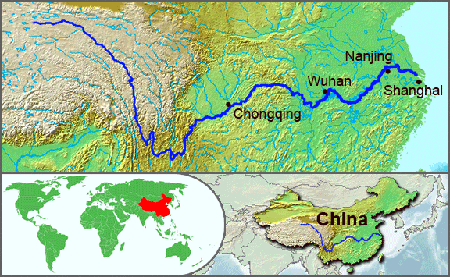
|
CHINA> About Yangtze River Basin
 |
|
About Yangtze River Basin
Updated: 2009-07-21 10:32 Rising in the Tanggula Mountains in west-central China, the Yangtze River flows southeast before turning northeast and then generally east across south-central and east-central China to the East China Sea near Shanghai. It is the world’s third longest river, 6,300 km long.
 Several large cities, including Shanghai, Nanjing, Wuhan, and Chongqing, lie in the river's basin, which is known as the granary of China. Large ships can sail to Wuhan, and smaller vessels can reach Yichang; it becomes harder to navigate above Yichang because of the gorges that occur between Chongqing and Yichang. Work on the Three Gorges Dam project was inaugurated in 1993; the dam was completed in 2006. Located west of Yichang, it will enable freighters to navigate 2,250 km inland from the East China Sea to Chongqing. Economy The economy of much of the Yangtze basin is focused largely on agricultural production, although inland cities such as Wuhan and Chongqing and the coastal region centred on Shanghai are among China’s most important industrial centres. The lower basin and the delta are among the most economically developed areas in the country. Mineral resources include reserves of iron ore near Wuhan and Nanjing and such deposits as coal, copper, phosphorus, gold, oil, and natural gas in Sichuan province. People The Yangtze basin contains a significant portion of China’s population, but distribution is uneven. The highland area of the river’s upper reaches is among the most sparsely settled regions in China, while the Yangtze delta has the country’s highest population density. Outside the delta the greatest concentrations of people are in the plains that adjoin the banks of the river and its tributaries in the middle and lower basins, especially in the vicinity of the cities of Chengdu, Chongqing, Wuhan, and Nanjing. These cities are among the largest in China, and Shanghai is the country’s most populous. In the highlands of the upper basin, the population consists mainly of ethnic Tibetans engaged in traditional animal husbandry and the cultivation of such hardy grains as barley and rye. The population of the Yunnan-Guizhou Plateau is a mixture of Chinese (Han) agriculturalists and numerous ethnic minorities who combine some farming with herding and hunting. The population of the middle and lower basins becomes progressively more Chinese, although, especially in the middle basin, many other national minorities are represented. History The Yangtze River basin is one of the longest-inhabited regions in China. Although much of China’s political history has centred around North China and the Yellow River basin, the Yangtze region always was of great economic importance to successive dynasties for its agricultural potential. The Grand Canal was built in order to transport grain from the Yangtze basin to the great northern capital cities; it is possible that the southernmost portion of the canal was in use as early as the 4th century bc, and much of it was constructed in the 7th century ad. Over the course of time the Yangtze has served as both a political and a cultural boundary. The river now demarcates the provinces constituting South China. The Yangtze also was the focus of many of the imperialist incursions into China in the 19th century and the first half of the 20th, with Shanghai at the river’s mouth becoming the main foreign commercial base. Since 1950 the river and its basin have been the focus of much of China’s economic modernization. |